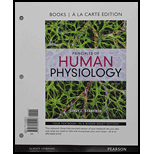
Introduction :
The stimuli can be defined as the external changes, which can trigger a physiological response in the body of an organism. If the stimuli are strong enough to make the changes to a threshold potential, then it can trigger a neural response to it.
Answer to Problem 1E
The correct answer is option (d).
Explanation of Solution
Explanation for the correct answer:
Option (a) the size of the receptor potential. The size of the receptor potential must be enough to reach the threshold and the size also determines the intesity of sensation.
Option (c) the frequency of the action potential. The frequency of the action potential can describe the frequency of the stimulus and the receptor potential. More the frequency of action potential, more will the intensity of the stimulus.
Option (d) (a) and (c). As the size of the receptor potential and the frequency of the action potential both determines the strength of the stimulus, the option (a) and (c) both are true. So, the correct answer is option (d).
Explanation for the incorrect answer:
Option (b) size of the action potential. The size of the action potential does not determine the strength of the stimulus. Once the potential is able to reach the threshold, it generates a neural response. Hence, it is an incorrect answer.
Option (e) is given as all of the above. As option (c) is incorrect, this option is also incorrect.
The size of the receptor potential and the frequency of the action potential both determines the strength of the stimulus. Hence, the correct answer is option (d).
Want to see more full solutions like this?
Chapter 10 Solutions
Principles of Human Physiology, Books a la Carte Plus Mastering A&P with Pearson eText -- Access Card Package (6th Edition)
 Human Anatomy & Physiology (11th Edition)BiologyISBN:9780134580999Author:Elaine N. Marieb, Katja N. HoehnPublisher:PEARSON
Human Anatomy & Physiology (11th Edition)BiologyISBN:9780134580999Author:Elaine N. Marieb, Katja N. HoehnPublisher:PEARSON Biology 2eBiologyISBN:9781947172517Author:Matthew Douglas, Jung Choi, Mary Ann ClarkPublisher:OpenStax
Biology 2eBiologyISBN:9781947172517Author:Matthew Douglas, Jung Choi, Mary Ann ClarkPublisher:OpenStax Anatomy & PhysiologyBiologyISBN:9781259398629Author:McKinley, Michael P., O'loughlin, Valerie Dean, Bidle, Theresa StouterPublisher:Mcgraw Hill Education,
Anatomy & PhysiologyBiologyISBN:9781259398629Author:McKinley, Michael P., O'loughlin, Valerie Dean, Bidle, Theresa StouterPublisher:Mcgraw Hill Education, Molecular Biology of the Cell (Sixth Edition)BiologyISBN:9780815344322Author:Bruce Alberts, Alexander D. Johnson, Julian Lewis, David Morgan, Martin Raff, Keith Roberts, Peter WalterPublisher:W. W. Norton & Company
Molecular Biology of the Cell (Sixth Edition)BiologyISBN:9780815344322Author:Bruce Alberts, Alexander D. Johnson, Julian Lewis, David Morgan, Martin Raff, Keith Roberts, Peter WalterPublisher:W. W. Norton & Company Laboratory Manual For Human Anatomy & PhysiologyBiologyISBN:9781260159363Author:Martin, Terry R., Prentice-craver, CynthiaPublisher:McGraw-Hill Publishing Co.
Laboratory Manual For Human Anatomy & PhysiologyBiologyISBN:9781260159363Author:Martin, Terry R., Prentice-craver, CynthiaPublisher:McGraw-Hill Publishing Co. Inquiry Into Life (16th Edition)BiologyISBN:9781260231700Author:Sylvia S. Mader, Michael WindelspechtPublisher:McGraw Hill Education
Inquiry Into Life (16th Edition)BiologyISBN:9781260231700Author:Sylvia S. Mader, Michael WindelspechtPublisher:McGraw Hill Education





